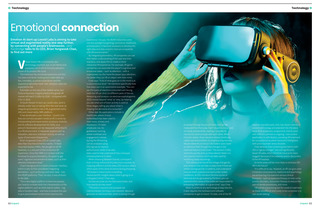




Technology Emotional connection Emotion-AI start-up Looxid Labs is aiming to take virtual and augmented reality one step further, by connecting with peoples brainwaves. Jane Bainbridge talks to its CEO, Brian Yongwook Chae, to find out more V irtual reality (VR) is not exactly new technology anymore, but, to all intents and purposes, were still at the early adoption phase of its product life-cycle. The hardware has remained expensive, and this has been one factor holding back wider take-up. But, inevitably, as prices come down and the experience becomes more real, adoption rates are expected to rise. Estimates on the size of the market varies, but Fortune Business Insights predicts the global VR market will reach $120bn by 2026 compared with $7bn in 2018. At South Korean AI start-up Looxid Labs, work is already under way on taking VR to the next level, by integrating biometrics into a VR, augmented reality (AR) and mixed reality (MR) platform. It has developed a user interface Looxid Link that can connect peoples minds to VR. It works by incorporating brainwave sensor accessory modules and its software development kit (SDK), so a persons brainwaves can be measured while theyre in a VR environment. It measures aspects such as relaxation, attention and brain activity, as well as types of brainwave frequencies. Brian Yongwook Chae, CEO of Looxid Labs, describes how the connection works. A headmounted display (HMD), like you get on all VR headsets, is a vital part of the immersive VR experience. Since the HMD is in contact with the forehead to acquire biometrics, its easier to get users cognitive and emotional states, such as their attention/relaxation level. Chaes background is in brain-computer interface, which is why he first considered integrating biometrics such as the eye and brain data into the VR/AR platforms. Then, he says, it was all down to the data. For a new digital platform to become popular, you have to consider both the characteristics of the digital platform, such as what data to collect log data or location data and how to analyse the user to give personalised content that improves the 62 experience, he says. As VR/AR industries came into the spotlight for gaming, commerce, healthcare and education, it became necessary to develop the right data and data analytics that are compatible with VR environments. By integrating biometrics, VR companies can use their better understanding of the user and their reactions, and apply this to create a more interactive VR experience. For example, VR game companies can associate the player s cognitive and emotional states such as attention with a superpower; so, the more the player pays attention, the better they can lift an object with their mind. Chae says: A lot of what goes on in the mind is at a subconscious level. He mentions specifically how that plays out in an automotive example. You can see the types of reactions consumers are having [with the VR car clinic] to different parts of the car. Measuring and analysis via electroencephalograms (EEG) moves beyond what to why, by helping you see what sort of brain activity is used at these stages, telling you about what is shaping the decisions of a consumer. Other real-life applications include in healthcare, where clinical biofeedback has been used to treat stress, anxiety and depression. Its been employed, too, for goalkeeper training, where workload and engagement indexes during the VR training can be analysed using EEG signals to improve performance, while it has also been used to help understand how a shopper chooses products in store. When choosing between brands, a shoppers brain is firing millions of tiny electrical impulses; by mapping different activity areas, EEG sensors detect which parts of the mind are active during shopping. VR research draws some compelling neuroscientific insights about what is going on in a shoppers mind, Chae says. So how accurate are the brainwave feeds, and how exactly do they work? The brains neurons and synapses are interconnected, forming a vast network. Neurons generate an electrical field, which is strong enough